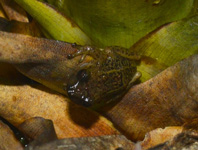Abstract
Indopamphantini trib. nov., a new tribe of subfamily Pamphantinae of family Geocoridae, is erected for Indopamphantus gen. nov., containing one species, I. makutaensis sp. nov., as the first member of this subfamily from the Oriental Region. The strikingly myrmecomorphic I. makutaensis, collected only from Makuta range area within Coorg [Kodagu] district at altitudes of up to 909 metres in the canopy of Vateria indica L. (Dipterocarpaceae), a tree indigenous to the Western Ghats in south India, is described and illustrated. The affinities of the new tribe with other tribes within the Pamphantinae as well with other related subfamilies of Geocoridae and families of Lygaeoidea are discussed. The Geocoridae and Pamphantinae are redefined to accommodate this new tribe.
References
Henry, T.J. (1997) Phylogenetic analysis of family groups within the infraorder Pentatomomorpha (Hemiptera: Heteroptera), with emphasis on the Lygaeoidea. Annals of the Entomological Society of America, 90 (3), 275-301.
https://doi.org/10.1093/aesa/90.3.275Henry, T.J. (2013) Cymapamphantus valentinorum, a new genus and species of Pamphantinae (Heteroptera: Lygaeoidea: Geocoridae) from the British Virgin Islands, with a checklist of the species and key to the tribes and genera of the subfamily. Proceedings of the Entomological Society of Washington, 115, 392–401.
https://doi.org/10.4289/0013-8797.115.4.392Henry, T.J., Dellape, P.M. & de Paula, A.S. (2015) Chapter 16 The Big-Eyed Bugs, Chinch Bugs, and Seed Bugs (Lygaeoidea). In: Panizzi, A.R. & Grazia, J. (Eds.), True Bugs (Heteroptera) of the Neotropics, Entomology in focus 2. Springer Science + Business Media Dordrecht (outside the USA), pp. 459–514.
https://doi.org/10.1007/978-94-017-9861-7_16Malipatil, M.B. (1978) Revision of the Myodochini (Hemiptera: Lygaeidae: Rhyparochrominae) of the Australian Region. Australian Journal of Zoology, Supplementary Series, 56, 1-178.
https://doi.org/10.1071/ajzs056Malipatil, M.B. (2012) Australocorinae, a new subfamily of Geocoridae (Hemiptera: Heteroptera: Lygaeoidea) from Australia, with descriptions of a new genus and two new species. Zootaxa, 3554, 75–88.
McIver, J.D. & Stonedahl, G.M. (1993) Myrmecomorphy: morphological and behavioural mimicry in ants. Annual Review of Entomology, 38, 351–279.
https://doi.org/10.1146/annurev.en.38.010193.002031Myers, N., Mittermeier, R.A., Mittermeier, C.G., da Fonseca, G.A.B. & Kent, J. (2000) Biodiversity hotspots for conservation priorities. Nature, 403, 853–858.
https://doi.org/10.1038/35002501Péricart, J. (2001) Family Lygaeidae Schilling, 1829 seed-bugs. In: Aukema, B. & Rieger, C. (Eds.), Catalogue of the Heteroptera of the Palearctic Region. Pentatomomorpha I. Vol 4. The Netherlands Entomological Society, Amsterdam, pp. 35–220.
Rengifo-Correa, L., Brailovsky, H., Henry, T.J. & Morrone, J.J. (2013) Phylogenetics and evolutionary morphology of the Neotropical true bug genus Epipolops (Hemiptera: Heteroptera: Geocoridae). Systematic Entomology, 39, 127–140.
https://doi.org/10.1111/syen.12039Schuh, R.T. & Slater, J.A. (1995) True bugs of the world (Hemiptera: Heteroptera). Classification and natural history. Cornell University Press, Ithaca, 336 pp.
Slater, J.A. (1964) A Catalogue of the Lygaeidae of the World. University of Connecticut, Storrs, CT, 1668 pp.
Slater J.A. (1981) Two new genera of Lygaeidae from northern Australia including the first member of the Pamphantini from the Eastern Hemisphere (Hemiptera: Heteroptera). Journal of Australian Entomological Society, 20, 111–118.
https://doi.org/10.1111/j.1440-6055.1981.tb01010.xSlater, J.A. (1999) The systematic position of the Pamphantinae with the description of two new tribes and a new species of Cattarus (Hemiptera: Lygaeoidea: Geocoridae). Acta Societatis Zoologicae Bohemicae, 63, 199–208.
Slater, J.A. & Henry, T.J. (1999) Notes on and descriptions of new Pamphantinae, including four species of Cattarus and a remarkable new myrmecomorphic genus and species (Heteroptera: Lygaeoidea: Geocoridae). Journal of the New York Entomological Society, 107, 304–330.
Srinivasa, Y.B., Arun Kumar, A.N. & Prathapan, K.D. (2004) Canopy arthropods of Vateria indica L. and Depterocarpus indicus Bedd. in the rainforests of Western Ghats, south India. Current Science, Bangalore, 86, 1420–1426.

